Paolo Gioli’s Vertical Cinema
August 2009
This essay first appeared in 45a Mostra Internazionale del Nuovo
Cinema (Pesaro, 2009). This catalogue is available
online here. I have revised
the essay slightly and included new illustrations.
It is my desire to intone the hymn of the male, the strong, the virile, active, vertical composition!
Sergei Eisenstein, 1930
The film image
has always been biased toward the horizontal. The classic 4:3 rectangle has been
the worldwide standard, and when it has varied, it has stretched lengthwise (CinemaScope,
Panavision). Within a shot, figures usually move laterally and the camera swivels
or travels accordingly. Apologists in the 1920s argued that this horizontality
was simply natural. Our eyes are mounted side by side, and we have more eye muscles
devoted to tracking objects on that axis than on the vertical one. Further, the
commentators argued, painters and other graphic artists had long preferred the
horizontal.
In 1930, as
the emergence of sound cinema made technicians reconsider the dimensions of the
image, Sergei Eisenstein proposed rethinking the rectangle. In his lecture, “The
Dynamic Square,” he argued that the 4:3 frame was inherited from academic
painting and the Western proscenium stage, and thus could not claim a source
in nature. He pointed out that Asia had strong traditions of vertical imagery,
notably in the picture scrolls of China and the woodblock prints of Japan. The
vertical dimension, he insisted, harbored just as many design resources as its
counterpart. “For thirty years we have been content to see excluded 50
per cent of compositional possibilities.”
Eisenstein
might have added that a curious disparity is embedded in film technology. Cinema’s
images are horizontal, but its engineering is not. In the camera, the printer,
the projector, and traditional editing machines like the Moviola, the film strip
moves from top to bottom, from feed reel to take-up reel. Claw and shutter seize
each frame and yank it down, snicking the next one into place. Even with today’s
platter projectors, the film must climb a winding path upward before making its
descent through the aperture. And when the film strip jams or drifts out of alignment,
it registers its trauma by leaping and bobbing, not yanking side to side. With
few exceptions (VistaVision, the Prevost and Steenbeck flatbed viewers), cinema
since the days of Edison and Lumière has been a machine that transported
its horizontal images along a steep vertical path.
Eisenstein’s
efforts to restore verticality to the cinema constituted a half-step: He sought
a “dynamic square” that would grant both axes equal weight. Paolo
Gioli has gone farther. Within the golden section of the 16mm frame, many of
his films expose and celebrate the vertical bias of the apparatus. In the process,
he reminds us of a period of cinema history in which the technical standards
were not yet fixed. In the course of these explorations he creates, through the
slithering rhythm of the film strip, new images of space, time, and corporeality.
Start
with the most obvious example: Gioli’s eccentric cameras. He could have
built them horizontally, paying a kind of homage to Muybridge’s experiments.
Instead, he followed the layout of the standard machine, making his pinhole cameras
stand upright, some of them one meter high. Gioli’s erect camera literally
takes the measure of its subject, like a meter-stick. In Film Stenopeico (1973/81/89)
each film strip presents the motif (window, furnishings, a woman’s body,
a clock, a landscape) from top to bottom, seizing its look from 47 slightly different
points in space. Run through the projector, however, the strip yields a spasmodic
flutter, the motif jerking insistently down the frame. If Muybridge turned time
into a comic-strip band, Gioli works in the other direction: an instantaneous
sampling of space becomes three seconds of cinema, rendered as a pulsating vertical
scan.
The downward
drift produced by Gioli’s stenopeic camera tends to erase the frameline.
Because there is no standard aperture, and because the film strip is not always
centered on the pinholes, we get a string of images that overlap the viewpoints
(Fig. 1). The film frame, that 4×3 rectangle promoted by Edison’s
Kinetoscope, was more or less standardized in the first decade of cinema (although
there were many alternatives, as Gioli’s work reminds us). The standard
frame segregates space, creating an image that will not slip. Once Gioli’s
camera abolishes the dividing lines, we have escaped the domination of the fixed
rectangle.
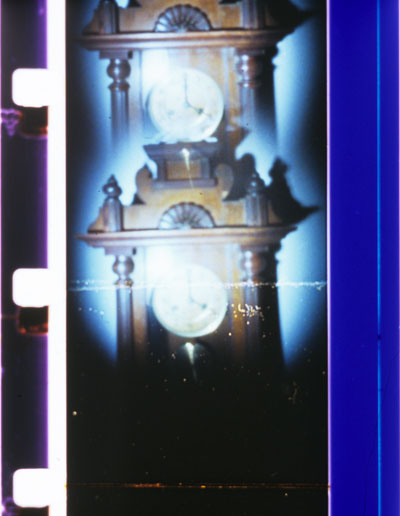
Figure
1
If there are
too few framelines in Film Steneopeio, Commutazione con mutazione (1969)
compensates, assaulting us with an epidemic of cellular structures. Once more
the movement is mostly vertical. But as the imagery wobbles down the frame, revealing
the oscillating soundtrack, perforations, scratches, hairs, clumps of dust, and
blobs of color, we are obliged to notice the arbitrariness of the rectangle.
Gridwork is superimposed on the stripes and blocks in the picture. Framelines
and perforations are sometimes tipped up, as if to create a tall aspect ratio
that will respect cinema’s downward flow. Often the film seems to be snagged
in the projector, stuttering or weaving frantically; sometimes framelines roll
past like an out-of-control television image. By spreading a narrow photograph
(vertical, of course) across two or more frames on the physical strip, Gioli
produces onscreen the cascade familiar from the pinhole footage: a pistol, a
steering wheel, trees, men, and women surge up and down in the tumult. Figure
2 shows the actual film strip, while Figures 3–5 show what we successively see,
in a rapid burst. Again, but more secretly, Gioli is scanning something—not
a plant or a woman’s breasts, but a picture.
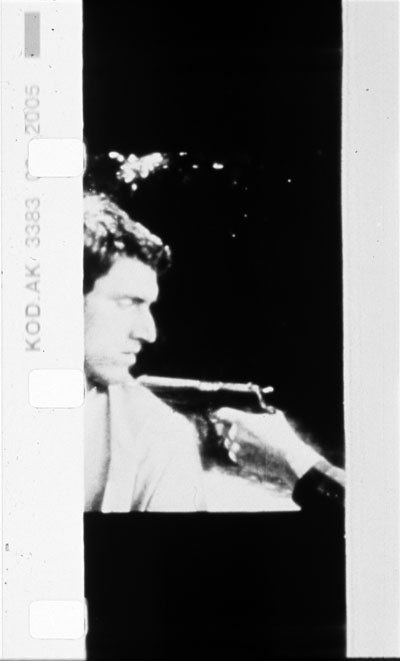
Figure 2
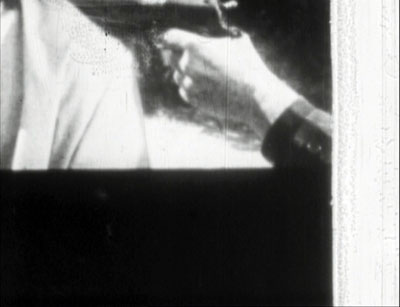
Figure 3
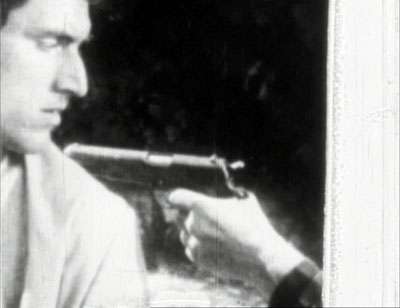
Figure 4
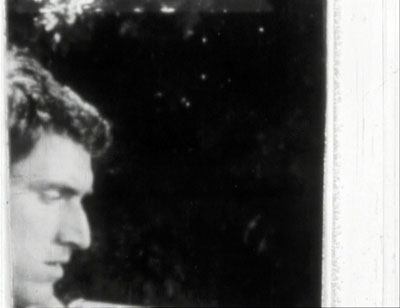
Figure 5
Gioli has
noticed that the very perforation that allows the film to be pulled down through
camera and projector echoes in miniature the frame enclosing the image. What
could make him happier than a film gauge that plants a perforation right on the
sacred frameline? The early amateur format, 9.5mm, set its single perforation
in the center of each horizontal edge. In L’operatore perforato (1979)
that plump sprocket hole comes into its own. It multiplies like a virus, riding
serenely on the surface, nearly obliterating the images trembling underneath
it. Near the close of the film, we watch another cameraman, perhaps shooting
a Fatty Arbuckle imitator, cope with the invasion of perforations, not only from
the top and center but from the edge. By now, when we can hardly tell the difference
between frame and perforations, cinema’s two round-cornered rectangles,
the image can be anything—a picture, or a zone of blank white (Fig. 6).
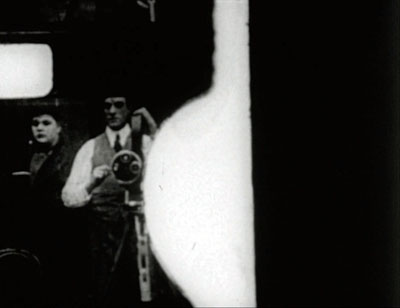
Figure 6
Gioli’s
most exhaustive essay in vertical cinema seems to me Anonimatograph (1972).
Out of a family’s home movies from the silent era he creates a fresco of
an epoch by magnifying casual and intimate domestic details. If Commutazione
con mutazione and L’operatore perforato scarred and punctured
the images that slid through the frame, something gentler informs this film.
Gioli shows us his optical printer at the start, superimposing it on the lovely
face of a woman. The shot announces a film that will move across various forms
of split imagery, in still frames as often as movement. First we get superimpositions,
then jump cuts, and finally and most lastingly divided frames. The settings themselves
are partitioned, with characters caught in doorways or three-sided mirrors.
Once
more, what is actually on the film strip is classically posed, but what we see
onscreen, broken by the shutter and the incessant dysfunctional framing, becomes
something altogether more fractured. Family members drop in and out, replacing
one another in diptychs or triptychs. The kaleidoscopic images suggest a jumble
of albums or stereopticon slides (Figs. 7–8). Truncated images are stacked up,
as when a soldier at a train window seems to gaze down at a nude woman stretched
luxuriantly on the parlor carpet. At one point, verticality seems to create horizontality:
two women at a party appear to clone themselves and spread across an entire room
(Fig. 9). Near the close of Anonimatograph comes the ultimate verticality:
a rain of tiny scratches all but obliterating the image.
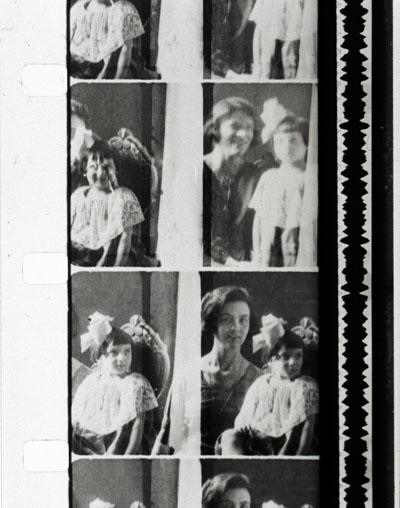
Figure 7
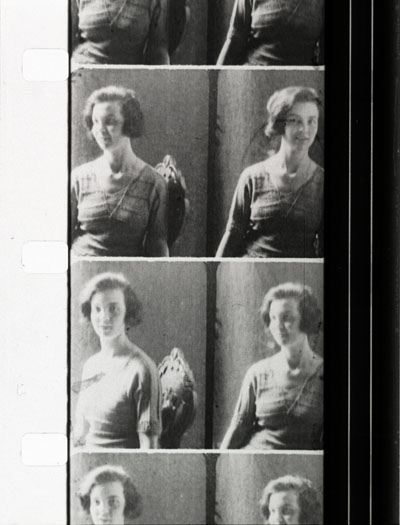
Figure 8
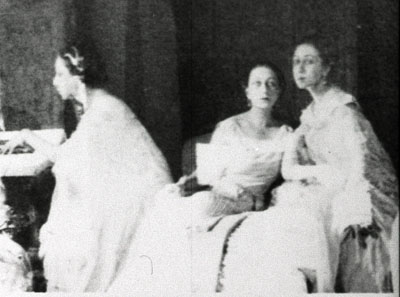
Figure 9
In the light
of this tendency in Gioli’s cinema, is it too much to see in Rothkofilm (2008)
a self-conscious homage to another master of the vertical axis? Granted, Rothko
often worked in a slightly horizontal format; but he also rehabilitated the upper
area of the picture plane. He showed that one massive patch of glowing color
stacked on another could provide a powerful counterweight, could even seem seem
to float upward. Gioli subjects the master’s paintings to the same vertical
replacements we find in the other films, though at a more measured pace. Edges
slide up and down, colors melt into one another, and by the end Rothko’s
oeuvre seems nothing but apertures and sprocket holes (Fig. 10). Rothko’s
monumental art evokes eternity, but in Gioli’s hands his slabs take on
a softer, more vulnerable quality. They become versions of the humble, luminous
rectangle through which film images plunge on their way to disappearing.
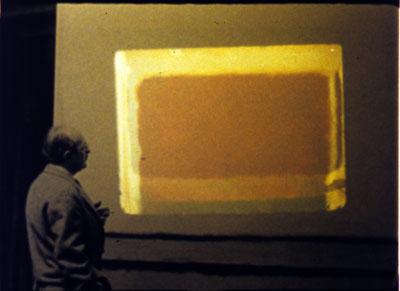
Figure 10
|
|



